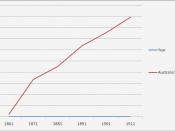Study Notes
How people lived in the Turn of the Century in Australia.
People lived by the Laissez Faire, government policy which did not interfere much in economic affairs and left individuals to look after themselves.
Many farmers walked off their farm as they couldn't afford to stay due to the drought. People started living in or near the capital cities.
There was much inequality in Australia and life for many working-class and rural people was marked by poverty.
Living as a working class person was tough, there were no benefits scheme until after Federation.
They lived in houses with no sewerage, indoor toilets and baths were rare. They had small and often crowded houses.
Social problems started to occur, such as drunkenness, prostitution, crime and begging.
Health was a constant problem. The slum conditions made it easy for disease to spread, rats brought further contamination.
There were no antibiotics before 1914 and medical knowledge was poor.
Few working-class people could afford doctors before 1914. There was no such thing as Medicare.
Higher Education was rare for a working class person.
Infant mortality was high.
But Higher Class people were quite the opposite. They had high amounts of money, shorter working hours, own businesses, they had access to doctors and mostly obtained a higher level of education than Lower Class people. They had time for leisure activities.
In the 1st decade of the 20th Century, Government began to construct a social welfare system (you had to be white)
Working Conditions at the Turn of the Century
Workers had no toilets (Some). Women in textiles were to bring work home although they were working 16 hours.
Workers could go to jail for asking for a pay rise. There was no overtime pay or any benefits.
Shop workers between 9a.m to 9.p.m...


